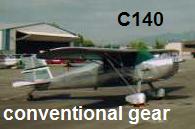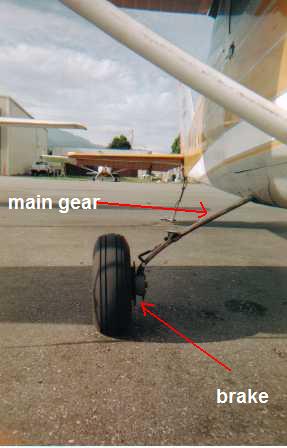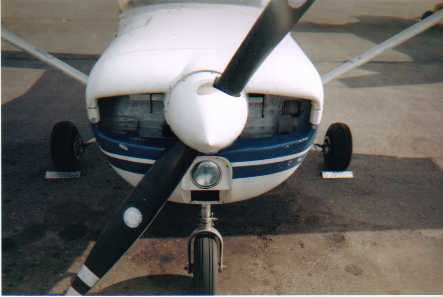|
Wheels and Brakes
The Wright Flyer didn't have wheels at all, but most airplanes
do. Until about fifty years ago, the normal configuration was
two main wheels just ahead of the centre of gravity, and one small wheel at
the back. This set up is still known as conventional gear, implying
that anything else is unconventional. You will also hear aircraft with a tailwheel
called taildraggers. The last is ironic, because the tailwheel
produces much less drag than the nosewheel on a tricycle gear airplane.
 Whereever your wheels are, it's important
to check that they are correctly and securely attached, that the tires are
properly inflated and in good condition, and that the brakes are aligned
and not excessively worn. Whereever your wheels are, it's important
to check that they are correctly and securely attached, that the tires are
properly inflated and in good condition, and that the brakes are aligned
and not excessively worn.
The C140 shown has wheel pants also called speed fairings
over the wheels. These look nice and reduce interference drag by streamlining
the wheels, thus add a couple of knots to the speed in cruise. Most flying
schools take the wheel pants off and leave them off because they interfere
with a thorough inspection of wheels and brakes, and increase the time required
for maintenance. Owners who fly out of muddy or snow covered fields will
also remove the wheel pants to keep them from being clogged up.
The tricycle gear is now the normal arrangement for airplane
wheels, with the sturdier main gear just aft of the centre of gravity. This
gives the airplane more stability landing or taxiing in a crosswind, but
the nosewheel is a vulnerable component. Improper landing technique can
damage not only the nosewheel, but the firewall, too. Always keep the nosewheel
off the ground until the mains are down, and then lower it gently, don't
drop it to the ground.
This Cessna 172 does not have a fairing over the gear, so you
can see the shape of the flat gear. It's basically a big spring that absorbs
the shock of landing, which is why if you land hard it can bounce you back
into the air. This picture shows the brake disc close to the wheel, and the
housing for the brake cylinder. You can also see the hydraulic line curling
up away from the brake. It runs up the gear strut under the floor to the
brake pedals. You can see another tailwheel airplane in the background under
the elevator.
 In this head-on picture of a C150 you can see the
bottom of the compression strut on the nosewheel gear. You should be able
to get three fingers in here below the outer sleeve, or there is not enough
inflation in the strut. In this head-on picture of a C150 you can see the
bottom of the compression strut on the nosewheel gear. You should be able
to get three fingers in here below the outer sleeve, or there is not enough
inflation in the strut.
These are all the pictures I have of airplane parts, but I
would appreciate more pictures, especially if you have pictures of special
characteristics of training aircraft, or aircraft defects encountered during
preflight.
This page written 12 November 2003 by Robyn Stewart.
Copyright 2003 Flying Start
Initiatives
|
Robyn's Flying Start Home

Flight Training
Overview of flight training
Air
Intakes
Carb heat, engine air and where it goes
Vents
Cabin air, overhead vents and OAT
Trims
Aileron trim, rudder trim and elevator trim
Antennae
Comm, VOR, ADF & ELT
Gear
Tricycle & conventional
Search
Search all of wabyn.net
Contact
Robyn
Send me e-mail
|